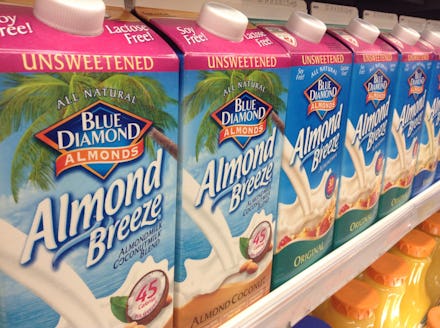No, Your Almond Milk Obsession Is Not Killing All the Bees

Almond is the new dairy — but it depends on an animal much smaller than a cow.
Your beloved almond milk requires almonds, which grow on trees with flowers, which require bees to pollinate them. And as the Atlantic noted in "The Dark Side of Almond Use," the booming almond industry needs a ton of bees.
For the past few decades, milk consumption in the United States has been falling as substitutes like soy, coconut or rice milk scramble to take its place. Almond milk recently emerged as the non-dairy winner, now representing two-thirds of the alternative beverage category, according to the CEO of WhiteWave, owners of the Silk brand and one of the largest producers in the United States. Baristas have perfected the art of almond milk cappuccinos and lattes. Many grocery stores offer not one but multiple brands of almond milk in the dairy aisle. And the thirst, as reported this week, is spreading overseas.
While most people choose almond milk for health reasons or out of concern for bovine welfare, most of us have no idea that our growing obsession with it relies so heavily on bees. The California almond industry, responsible for 80% of the world's production, trucks in 1.6 million honeybee colonies to pollinate their orchards each year. That's about half of the honeybees in the entire United States.
Beekeepers from as far as the East Coast pack their bees to meet the spring almond bloom in California. And the bees are a hot commodity: These services cost the almond industry more than $292 million dollars and represent a significant portion of a beekeeper's annual income. If we want our almonds, we're going to need bees.
So are almonds good or bad for the bees? The health of honeybees became a national issue in 2006 when beekeepers reported losing up to 90% of their hives. The mysterious disease killing the bees became commonly known as colony collapse disorder. Suddenly people who had never thought twice about pollinators began gloomily realizing that bees were responsible for 1 in every 3 mouthfuls of food we eat. When there's a large die-off of bees, people take note.
Things weren't looking good for the bees this year. At the end of the 2014 almond bloom, 15% to 25% of the bee colonies brought in to pollinate the orchards had been damaged in some way. The Pollinator Stewardship Council blamed the losses on chemicals, specifically a process called tank-mixing – when pesticides and fungicides are sprayed together, usually to save time on application. Though the practice is legally allowed, it can have devastating effects on pollinators like the honeybee. During a meeting with the EPA, many beekeepers said they might not return for the 2015 almond bloom, or they would add pesticide charges on top of their normal colony rental price.
Despite this, most beekeepers need the almond industry to make a living. As Mother Jones noted, beekeepers make more money from pollinating almond trees than by selling the honey they produce. When asked what beekeepers would do if California almonds disappeared tomorrow, the Almond Board's associate director Bob Curtis told Mic that many of them have said they'd be put out of business. So bees need beekeepers, beekeepers need pollination income and the almond growers need bees. It's a relationship of codependence.
That's not necessarily a bad thing. By and large, the almond industry may be the best example of humans not only profiting from animals or insects but actually caring about their well-being. It could be the only perfectly symbiotic relationship in agriculture. Last year's die-off isn't a common occurrence, and it's a serious issue that almond growers tried to remedy immediately. After all, they need the bees to stay alive.
As part of this commitment to bee health, the California Almond Board recently released new Best Management Practices to make sure orchards are safe for bees. Though there are no penalties for not following guidelines, alienating beekeepers would be self-inflicted punishment enough. Some of the beekeeper-grower agreements include being more open about pesticide use, as well as making sure there are food sources available nearby once almond trees have stopped blooming. (Foraging bees can travel up to four miles, easily becoming exposed to pesticides outside of the nearby almond groves.)
There is, of course, a most basic element of the equation that's less than ideal. These are, as the Atlantic referred to them, "mercenary pollinating bees," kept alive and working for human needs. But those human needs include keeping them incredibly healthy.
"The [almond] growers by and large want to do the right thing and be partners with the beekeepers," Curtis says, adding, "It's extremely important that almonds remain a good and safe place for bees because we require so many of them." As Mother Jones pointed out, the idea that bee-reliant almond growers would do anything to harm the bees is "just nuts."
So far as honeybees are concerned, you can feel OK about your almond milk. The next time you pick up a carton, remember you're not only letting cows off the hook — you're also keeping millions of bee colonies employed and well-fed on delicious almond blossoms.